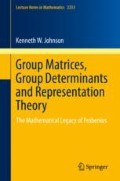Abstract
In Chap. 1 it is explained that if p is a probability on a finite group G the group matrix X G(p) is a transition matrix for a random walk on G. If f is an arbitrary function on G the process of transforming X G(f) into a block diagonal matrix is equivalent to the obtaining the Fourier transform of f. This chapter explains the connections with harmonic analysis and the group matrix. Most of the discussion is on probability theory and random walks.
The fusion of characters discussed in Chap. 4 becomes relevant, and also the idea of fission of characters is introduced, especially those fissions which preserve diaonalizability of the corresponding group matrix. As an example of how the group matrix and group determinant can be used as tools, their application to random walks which become uniform after a finite number of steps is examined.
Access this chapter
Tax calculation will be finalised at checkout
Purchases are for personal use only
References
S. Agaian, J. Astola, K. Egiazarian, Binary Polynomial Transforms and Nonlinear Digital Filters (Marcel Dekker, New York, 1995)
D. Aldous, Random walks on finite groups and rapidly mixing Markov chains, in Séminaire de Probabilités, XVII. Lecture Notes in Mathematics, vol. 986 (Springer, Berlin 1983), pp. 243–297
L. Auslander, P. Tolmieri, Is computing with finite Fourier transforms pure or applied mathematics? Bull. Am. Math. Soc. (N.S.) 1, 847–897 (1979)
D. Bayer, P. Diaconis, Trailing the dovetail shuffle to its lair. Ann. Appl. Probab. 2, 294–313 (1986)
E. Borel, A. Chéron, Théorie Mathématique du Bridge á la Portée de Tous (Gauthier-Villars, Paris 1940)
R. Brauer, Über die Kleinsche Theorie der algebraischen Gleichungen. Math. Ann. 110, 473–500 (1935)
E.O. Brigham, The Fast Fourier Transform (Prentice-Hall, Englewood Cliffs, 1974)
C.S. Burrus, T.W. Parks, DFT/FFT and Convolution Algorithms: Theory and Implementation (Wiley, New York, 1985)
T. Ceccherini-Silberstein, F. Scarabotti, F. Tolli, Harmonic Analysis on Finite Groups. Cambridge Studies in Advanced Mathematics, vol. 108 (Cambridge University Press, Cambridge, 2008)
J.W. Cooley, The re-discovery of the fast Fourier transform algorithm. Mikrochim. Acta III, 33–45 (1987)
P.J. Davis, Circulant Matrices (Chelsea, New York, 1994)
P. Diaconis, Group Representations in Probability and Statistics (Institute of Mathematical Statistics, Hayward, 1988)
P. Diaconis, The cutoff phenomenon in finite Markov chains. Proc. Nat. Acad. Sci. 43, 1659–1664 (1995)
P. Diaconis, Random walks on groups: characters and geometry, in Groups St. Andrews 2001 in Oxford, vol. I. London Mathematical Society Lecture Note Series, vol. 304 (Cambridge University Press, Cambridge, 2003), pp. 120–142
P. Diaconis, D. Rockmore, Efficient computation of the Fourier transform on finite groups. J. Am. Math. Soc. 3, 297–332 (1990)
P. Diaconis, M. Shahshahani, Generating a random permutation with random transpositions. Z. Wahrsch. Verw. Geb. 57, 159–179 (1981)
M.T. Heidemann, D.H. Johnson, C.S. Burrus, Gauss and the history of the fast Fourier transform. Arch. Hist. Exact Sci. 34, 265–277 (1985)
S.P. Humphries, K.W. Johnson, A. Misseldine, Commutative S-rings of maximal dimension. Commun. Algebra 43, 5298–5327 (2015)
J. Karlof, The subclass algebra associated to a finite group and a subgroup. Trans. Am. Math. Soc. 207, 329–341 (1975)
D. Kosambi, U.V.R. Rao, The efficiency of randomization by card shuffling. J. R. Stat. Soc. A 128, 223–233 (1958)
D.A. Levin, Y. Peres, E.L. Wilmer, Markov Chains and Mixing Times (American Mathematical Society, Providence, 2009)
G.W. Mackey, Harmonic analysis as the exploitation of symmetry—a historical survey. Bull. Am. Math. Soc. (N.S.) 3, 543–698 (1980)
G.W. Mackey, The Scope and History of Commutative and Noncommutative Harmonic Analysis. History of Mathematics, vol. 5 (American Mathematical Society, Providence; London Mathematical Society, London, 1992)
D.K. Maslen, D.N. Rockmore, Separation of variables and the computation of Fourier transforms on finite groups. J. Am. Math. Soc. 10, 169–214 (1997)
D.K. Maslen, D.N. Rockmore, The Cooley-Tukey FFT and group theory. Notices Am. Math. Soc. 48, 1151–1160 (2001)
H.J. Nussbaumer, Fast Fourier Transform and Convolution Algorithms (Springer, Berlin, 1981)
A. Okounkov, A.M. Vershik, A new approach to the representation theory of the symmetric groups. Sel. Math. (N.S.) 2, 581–605 (1996)
H. Poincaré, Sur l’intégration des équations linéaires et les périodes des intégrales abéliennes. J. des Math. Pures Appl. 9(5), 139–212 (1903), Oeuvres 3, 106–166
H. Poincaré, Calcul des Probabilités (Gautier-Villars, Paris, 1912)
F. Roesler, Darstellungstheorie von Schur-Algebren. Math. Zeitshrift 125, 32–58 (1972)
L. Saloff-Coste, Random Walks on Finite Groups, in Probability on Discrete Structures Encyclopaedia of Mathematical Sciences, vol. 110 (Springer, Berlin, 2004), pp. 263–346
J.D.H. Smith, Induced class functions are conditional expectations. Eur. J. Comb. 10, 293–296 (1989)
R.S. Stanković, C. Moraga, J. Astola, Fourier Analysis on Finite Groups with Applications in Signal Processing and System Design (Wiley-IEEE Press, Hoboken, 2005)
L. Takács, Harmonic analysis on Schur algebras and its applications in the theory of probability, in Probability Theory and Harmonic Analysis, ed. by J.-A. Chao, W.A. Woyczyński (Marcel Dekker, New York, 1986)
A. Terras, Fourier Analysis on Finite Groups and Applications. London Mathematical Society Student Texts, vol. 43 (Cambridge University Press, Cambridge, 1999)
R. Tolmieri, M. An, C. Lu, Algorithms for Discrete Fourier Transforms and Convolutions (Springer, New York, 1989)
A.L. Vyshnevetskiy, E.M. Zhmud’, Random walks on finite groups converging after finite number of steps. Algebra Discret. Math. 2, 123–129 (2008)
E. Wigner, Restriction of irreducible representations of groups to a subgroup. Proc. R. Soc. Lond. Ser. A 322, 181–189 (1971)
Author information
Authors and Affiliations
Rights and permissions
Copyright information
© 2019 Springer Nature Switzerland AG
About this chapter
Cite this chapter
Johnson, K.W. (2019). Fourier Analysis on Groups, Random Walks and Markov Chains. In: Group Matrices, Group Determinants and Representation Theory. Lecture Notes in Mathematics, vol 2233. Springer, Cham. https://doi.org/10.1007/978-3-030-28300-1_7
Download citation
DOI: https://doi.org/10.1007/978-3-030-28300-1_7
Published:
Publisher Name: Springer, Cham
Print ISBN: 978-3-030-28299-8
Online ISBN: 978-3-030-28300-1
eBook Packages: Mathematics and StatisticsMathematics and Statistics (R0)

